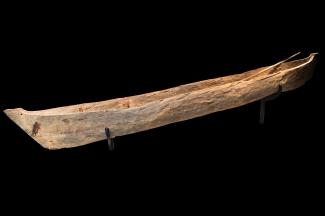Iwaidja man Robert Cunningham from the Cobourg Peninsula made this dugout canoe in the 1960s in the classic style used by Aboriginal groups across the Northern Territory and in the Kimberley, Western Australia. Dugout canoes were probably introduced into the northern Kimberley by local interaction with Indonesian fishers rather than the result of diffusion from the Northern Territory where past interactions between coastal Aboriginal groups and Indonesian seasonal visitors are well documented.
A later addition of sewn strakes to the hulls of canoes was possibly influenced by either Middle Eastern, Southeast Asian or European mariners who sailed northern Australian waters in the second half of the 19th century.
Prior to the introduction of dugout watercraft, northern Aboriginal coastal groups made bark canoes, typically from eucalyptus trees or mangrove log rafts. ‘Swimming logs’ were still in use on the east Kimberley coasts in the early 1900s rather than dugouts.
Abandoned vessels
It is highly likely that the dugout form is based on Indonesian examples sometimes left ashore by fishers or taken by Aboriginal people. Canoes were still being abandoned in the 1970s, with one example recorded by former WA Museum archaeologist, Ian Crawford, that had drifted into Napier Broome Bay in 1987.
Depictions of canoe type watercraft are present at both coastal and inland rock art sites in the Kimberley and Northern Territory.

